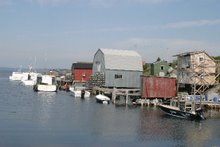
Introduced in the late 1960s and early 1970s, salmon aquaculture today produces greater tonnages of salmon a year than wild catches. Just go to the grocery store and you’ll find farm-raised salmon for about $5 per poound (on sale) while wild salmon hovers near $10-14 (at least in my area, this may be significantly different if you live near major fish ports). Though some folks claim that there’s a significant difference between the two types of salmon, it’s just likely to be positive attribution error, or simply that wild-caught salmon is more carefully prepared. Either way, many consumers, including myself, find the farm-raised salmon to be an excellent way to add salmon to their diets.
Critics of the methods of industrialized salmon farming have been many and varied. Among the criticisms leveled against it are that it spawns algal blooms due to the nitrogen content in the concentrated fish waste, that it leads to interbreeding between farmed and wild stocks–thus reducing the genetic variability of wild stocks and increasing their susceptibility to mass disease–, and that it destroys crucial shallow estuarine ecosystems by virtue of the fact that farming salmon is easiest near shore. These criticisms have paradoxically led to either one of two decisions if you are eco-conscious: 1) eat much less fish that is wild-caught from only the most carefully managed fish stocks ($$$$), or 2) don’t eat fish. For those of us without the $$$$ and that like fish, we are stuck with a poorly-regulated, dirty, destructive source of this occasional delicacy.
Like most frustrating aspects of environmental protection, aquaculture is not going to disappear, in fact given the reasons I discussed above it is likely only to intensify. In an excellent and lengthy article in today’s NYTimes Magazine, Paul Greenberg discusses what may take aquaculture from big niche industry to big business: Cod Farming. Once thought so abundant that no amount of fishing could decrease their yields, Cod fueled the growth and prosperity of colonial America, and much of the shipping and fishing fleets of Atlantic Europe. But of course, “they” were wrong and Cod stocks plummeted to un-fishable levels in the 1980s and 1990s. Cod farming may help to change all that by reducing pressure on the wild stocks and by helping to re-energize recently destitute stretches of northern coastlines.
But farming Cod is a tricky business–far trickier than salmon. To reach profitability, farmers have had to overcome a host of obstacles including cannibalization, premature sexual maturity, and low survival rates that plagued early efforts. The article describes these obstacles and how they may be overcome. The bottom line is that large-scale commercial cod farming may become a reality in the next decade. And, of course, cod is just the first foray into farming the bulk of ocean fish species. Tuna, swordfish, and host of others are next.

1 comment:
It would be truly amazing if they could get this program in action; however, I myself would see cod farming much harder then even tuna farming if I would not be so bold to say so. Tuna farming’s main difficulties would be, you would need much larger cages, and it would take the tuna a longer period to mature. However, with cod there are the problems in the article not to mention that cod are bottom feeders, and a huge amount of fish in a cage feeding off the bottom would cause many diseases, and most likely attract worms, which can be found in wild cod as well. Most other fish like salmon and tuna’s, feed in the middle and at the surface, which eliminates these treat from occur. However, I am sure we can find a way around it, we have the technology, and in the future humankind will most likely look for our protein from farmed fish, because of decline numbers of most open ocean fish stocks.
Post a Comment